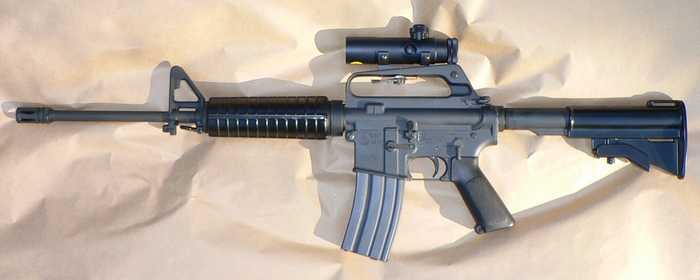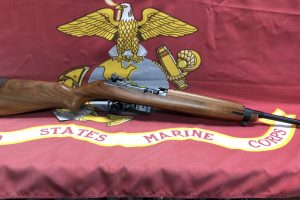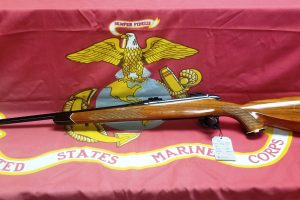Caliber Modularity at its Finest
The design of the AR-15/M-16 firearm platform started 60 years ago in 1957 with Armalite scaling down the AR-10 weapon system to be compatible with the 5.56x45mm. During the late 50s and early 60s, the design was finalized and adopted by all of the U.S. Armed Forces in one form or another. But, a bit strangely, Colt released it on the civilian market as the AR-15 prior to military series adoption, and that is where the long lived affair started between the American public and the AR-15.
The AR-15 firearm was initially released by Colt in the .223 Remington cartridge, which is dimensionally identical to the 5.56x45mm cartridge with a slightly modified chamber throat and loaded to marginally lower pressures.
But, as with all things firearms related in the United States, folks started to tinker with the AR-15 to change its chamberings and enhance its capabilities towards specific tasks.
I am not going to get into ALL of the different chamberings that the rifle has been chambered in, but am going to list the majority of them and then talk a bit about the mainstream SAAMI chamberings available today that have factory ammunition available for them and barrels available from more than one company.
Here is a quick list of the centerfire calibers that the AR-15 has been chambered in over the years as either factory offerings or as wildcats based on other calibers offered that will feed from magazines as designed.
Inch Measurement:
.17 MachIV, .17 Remington, .17 Remington Fireball, .17x.223, .17x.204 Ruger, .17 Tactical, .19 Calhoon, .19×223 Calhoon, .20 Tactical, .20 Practical, .204 Ruger, .20 PPC, .20×6.8, .20 LBC, .219 WASP-C, .221 Fireball, .222 Remington, .223 Remington, .223 Remington Ackley Improved, .223 Boz, .22 PPC, .22 LBC, .22 Nosler, .223 Winchester Super Short Magnum, .224 AR, .22×6.8, .224 Valkyrie, .243 LBC, .243 Winchester Super Short Magnum, .25×6.8, .257 Bobcat, .25-45 Sharps, .264 LBC, .270 AR, .277 Wolverine, .30 Carbine, .30 Herrett, American 30, .30 Remington AR, .300 AAC Blackout, .300 Whisper, .300 Sabre, .30 Coyote, .30×6.8, .339×39, .35/40, .35×44, .338 Spectre, .357 Sig, .357 Automag, .358 Yeti, .375 Reaper, .375 SOCOM, .40 S&W, .44 Remington Magnum, .44 Automag, .440 CorBon Magnum, .45 ACP, .450 Bushmaster, .458 SOCOM, .475 Tremor, .499 LW, .50 Beowulf, .50 Action Express, .640 Express Magnum.
Metric Measurements:
5.45x39mm, 5.56x42mm, 5.56x45mm NATO, 5.7x28mm FN, 6x45mm, 6×6.8, 6mm Hagar, 6mm PPC, 6mmAR, 6mm AR Turbo, 6mm Dasher, 6mm Fat Rat, 6PDK, 6mm BR, 6mm BRX, 6.5x40mm, 6.5 BR, 6.5 BRX, 6.5×6.8, 6.5mm Patriot Combat Cartridge, 6.5 Grendel, 6.9x39mm, 6.8 Reminton SPC, 7x40mm, 7mm sCAR, 7mm BR, 7mm Valkyrie, 7.62×24, 7.62x37mm Mustang, 7.62x39mm, 7.62x40mm Wilson Tactical, 9mm Parabellum, 9x23mm, 10mm Auto, 10mm SOCOM.
There could be some I missed, and I didn’t include any rimfire options that have been made either, but thats the majority of the ones that have been made or are being made.
Here are the rifle calibers that are currently available, considered mainstream, and have SAAMI adopted standards with factory ammunition available for them.
.223 Remington/5.56x45mm NATO: The caliber that started it all for the AR platform, a very useful cartridge with bullet weights available in loaded ammo from 35 grains up to 77 grains, and component bullets available from 33 grains up to 90 grains. Depending on your barrels twist and bullet choice, it is a viable choice for varmint hunting, predator hunting, deer hunting (depending on your states laws), defensive use, and target/competition use. There are several ways the barrels are chambered, the normal .223 Remington chamber, the longer throated 5.56x45mm NATO chambering, and the “hybrid” .223 Wylde chamber that is a combination of the two to try and enhance accuracy of the .223 Remington loads when used in a chamber that can safely shoot 5.56x45mm NATO also.
6.5 Grendel (also known as 6.5×39, and .264 LBC): The Grendel was designed by Bill Alexander and Janne Pohjoispää in 2002-2003, and adopted by SAAMI in 2011. It was designed to be a 200-800 yard cartridge that could still be magazine fed in a standard length AR-15 magazine, while having superior ballistics to the standard .223 Remington/5.56x45mm NATO rounds. Factory ammunition is loaded with bullets weighing between 90 grains up to 130 grains, and reloaders have the use of bullets weighing from 85 grains up to 156 grains. This is one of the best all-around multipurpose cartridges you can put in an AR-15. With the correct bullet choice you can use it for varmint hunting, predator hunting, deer, hog, and elk hunting, personal defense, and of course target/competition shooting all at distances farther than any of the other AR-15 chamberings, and with better ballistics when the bullet arrives on target.
.204 Ruger: This is a .20 caliber round developed by Ruger in cooperation with Hornady in 2003. It is primarily a varmint hunting round where speed and flat trajectory are more important than bullet mass. The Hornady 32 grain V-Max load generates 4225 feet per second. Factory loads are available with bullets weighing between 24 grains and 45 grains, and reloaders have bullets available from 24 grains up to 55 grains.
.300 AAC Blackout/.300 Whisper: This is a caliber that was designed by JD Jones of SSK Industries back in the early 1990s, based on the .221 Fireball case. With factory ammo available in bullets weighing from 90 grains up to 220 grains, and reloaders having bullets weighing from 79 grains up to 240 grains. The supersonic ballistics with this cartridge are comparable to the 7.62x39mm, and in subsonic loads, its comparable to the .45 ACP.
6.8 Remington SPC: This cartridge was designed to improve on the close range ballistics of the 5.56x45mm NATO round for combat use at 0-300 yards. There has been a good amount of people who have started using this round since it was pushed to market by Remington Arms. The factory ammo is available in bullets weighing from 85 grains up to 120 grains, with component bullets available in weights from 85 grains up to 130 grains. Due to the long case length, the cartridge requires bullets that are short to be used, and as such, this round loses a lot of energy quickly, and while a decent round for its intended purpose, there are much more capable rounds that provide better performance overall.
.450 Bushmaster: This cartridge was developed by Tim LeGendre with insight from Jeff Cooper on his vision of a big, heavy game round for the AR-15 rifles. And it delivers that, in spades. The factory loads launch a 250 grain bullet at 2200 feet per second. The factory loads are made in 220 grain up to 260 grains, and reloaders have bullets from 200 grains up to 325 grains. This round is a formidable one capable of taking very large game like elk or moose out to 250 yards.
Overall, the AR-15/M-16 is one of the most modular systems, if not THE most, available to the shooting public. You can tailor your gun to many specific uses from long-range competition to short-range 2-gun/3-gun competition, to hunting animals of all different sizes and distances, while shooting suppressed or unsuppressed. If you like to tinker with your guns and loads, there is a plethora of different possibilities in the AR-15 for you. And if you just want to buy your rifle and ammo from the store and not worry about anything besides just putting lead downrange, there is something for you also.
written by Jim Hanson






Leave a Reply
Your email is safe with us.